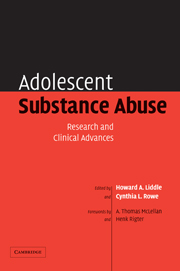Book contents
- Frontmatter
- Contents
- List of contributors
- Forewords
- Acknowledgements
- List of abbreviations
- 1 Treating adolescent substance abuse: state of the science
- Part I Theoretical, empirical, and methodological foundations for research in adolescent substance abuse treatment
- 2 The developmental context for adolescent substance abuse intervention
- 3 Recent methodological and statistical advances: a latent variable growth modeling framework
- 4 Clinical course of youth following treatment for alcohol and drug problems
- 5 Cannabis Youth Treatment intervention: preliminary findings and implications
- Part II Practice and policy trends in treatment for adolescent substance abuse
- Part III Comprehensive assessment and integrative treatment planning with adolescent substance abusers
- Part IV Empirically based interventions for adolescent substance abuse: research and practical implications
- Part V Culturally based treatment development for adolescent substance abusers
- Part VI Building the future
- Index
- References
2 - The developmental context for adolescent substance abuse intervention
from Part I - Theoretical, empirical, and methodological foundations for research in adolescent substance abuse treatment
Published online by Cambridge University Press: 26 August 2009
- Frontmatter
- Contents
- List of contributors
- Forewords
- Acknowledgements
- List of abbreviations
- 1 Treating adolescent substance abuse: state of the science
- Part I Theoretical, empirical, and methodological foundations for research in adolescent substance abuse treatment
- 2 The developmental context for adolescent substance abuse intervention
- 3 Recent methodological and statistical advances: a latent variable growth modeling framework
- 4 Clinical course of youth following treatment for alcohol and drug problems
- 5 Cannabis Youth Treatment intervention: preliminary findings and implications
- Part II Practice and policy trends in treatment for adolescent substance abuse
- Part III Comprehensive assessment and integrative treatment planning with adolescent substance abusers
- Part IV Empirically based interventions for adolescent substance abuse: research and practical implications
- Part V Culturally based treatment development for adolescent substance abusers
- Part VI Building the future
- Index
- References
Summary
The first purpose of this chapter is to identify the risk and protective factors related to adolescent drug use, emphasizing the importance of the parent–child relationship. The framework is derived from family interactional theory. Operating within a developmental perspective, we explore the interrelations of risk and protective factors related to drug use. A second goal of the chapter is to elucidate the protective factors that mitigate adolescents' vulnerability to drug use, as well as enhance other protective factors. Finally, we consider the implications of etiological research on the risk and protective factors and their interactions for prevention and treatment based on a number of major studies undertaken since the mid-1990s.
Drug use and abuse are costly problems that affect the health and well-being of individuals and families. Despite a decline in drug use during the early 1990s, there has since been a subsequent increase (Bachman et al., 1997). The personal, social, medical, and legal costs of adolescent drug use and abuse are considerable (Hawkins, Catalano, & Miller, 1992; Wallace & Muroff, 2002).
This chapter integrates findings from several cross-sectional and longitudinal studies conducted since the late 1980s on the psychosocial risk and protective factors for drug use and abuse. Risk factors precede drug use, increasing the probability of later drug use and abuse. Protective factors ameliorate the effect of these risk factors or enhance those of other protective factors leading to less drug use.
- Type
- Chapter
- Information
- Adolescent Substance AbuseResearch and Clinical Advances, pp. 25 - 51Publisher: Cambridge University PressPrint publication year: 2006
References
- 13
- Cited by

